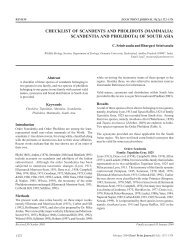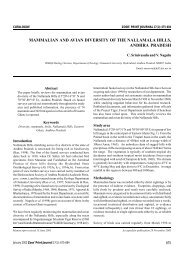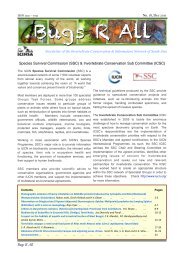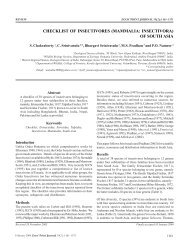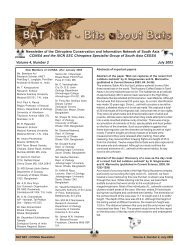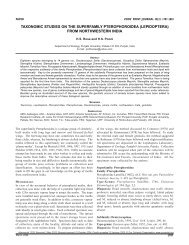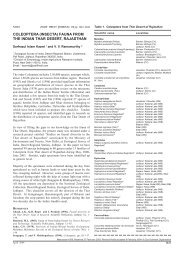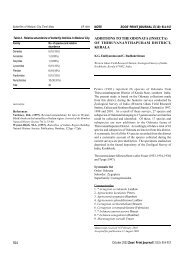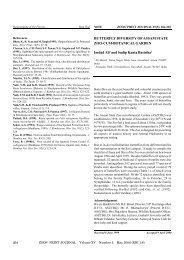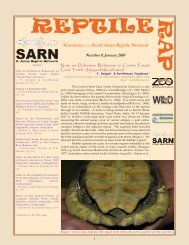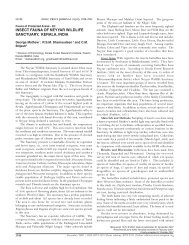Hosagoudar Biogeographical distribution 1492 - zoos' print
Hosagoudar Biogeographical distribution 1492 - zoos' print
Hosagoudar Biogeographical distribution 1492 - zoos' print
You also want an ePaper? Increase the reach of your titles
YUMPU automatically turns print PDFs into web optimized ePapers that Google loves.
REVIEW ZOOS' PRINT JOURNAL 21(12): 2495-2505<br />
BIOGEOGRAPHICAL DISTRIBUTION OF MELIOLACEAE MEMBERS IN INDIA<br />
V.B. <strong>Hosagoudar</strong><br />
Microbiology Division, Tropical Botanic Garden and Research Institute, Palode, Thiruvananthapuram, Kerala 695562, India<br />
Email: vbhosagoudar@rediffmail.com<br />
ABSTRACT<br />
This paper gives an account of 533 taxa belonging to the<br />
meliolaceous genera: Amazonia (27), Appendiculella (8),<br />
Armatella (12), Asteridiella (60), Irenopsis (27), Meliola (397)<br />
and Prataprajella (2) known from India. <strong>Biogeographical</strong>ly,<br />
India has been classified into ten regions. Of these, the<br />
Trans Himalayan, Desert, Semi Arid and Coastal vegetations<br />
are apparently devoid of meliolaceous taxa. The Western<br />
Ghats is presently represented by 488 taxa (Amazonia 24,<br />
Appendiculella 5, Armatella 12, Asteridiella 54, Irenopsis 26,<br />
Meliola 365 and Prataprajella 2), and the Himalayan region 12<br />
taxa (Amazonia 1, Appendiculella 1, Asteridiella 1 and Meliola<br />
9). Deccan region 16 taxa (Amazonia 1, Appendiculella 1,<br />
Asteridiella 1 and Meliola 13), Gangetic plain with 39 taxa<br />
(Amazonia 1, Appendiculella 4, Armatella 1, Asteridiella 5,<br />
Irenopsis 1 and Meliola 27), northeastern India with 7 taxa<br />
(Amazonia 1, Meliola 6) and all the Islands represent three<br />
species (of the genus Meliola). Bio-geographically, most of<br />
the fungi are restricted in their <strong>distribution</strong> to a particular<br />
region, but there are a few which are common to Eastern and<br />
Western Ghats, Western Ghats and Himalayan region,<br />
Eastern Ghats and Himalayan regions and Western Ghats<br />
and the Islands.<br />
KEYWORDS<br />
Biogeography, <strong>distribution</strong>, India, meliolaceae<br />
India occupies a strategic position in Asia, comprising all types<br />
of physiographical regions such as snow clad regions in the<br />
Himalaya, highest rainfall areas in Assam and Karnataka, deserts<br />
in Rajasthan, hilly tracts in the Eastern and Western Ghats and<br />
coastlines along the eastern and western sides of peninsular<br />
India. It has mainly three seasons in a year, viz., rainy season<br />
(June to September and October to November), winter season<br />
(October to February) and summer season (March to June).<br />
The forest cover is 19.27% of the total geographic area. Of this,<br />
11% has dense forest, while, the remaining are open forest.<br />
The total number of species of Phanerogams in India is<br />
estimated to be 45,000, of which 17,000 have been described.<br />
Of these, 40-45% is endemic to the region and are largely<br />
concentrated in the western Himalaya, eastern Himalaya and<br />
peninsular India (Sharma et al., 1993).<br />
The author has been engaged in the study of foliicolous fungi<br />
in India, an attempt is made here to record the <strong>distribution</strong> of<br />
the known meliolaceous fungal members in India. This will<br />
help to focus on the regions which have not been adequately<br />
studied and where future work should be focused.<br />
Meliolaceae<br />
Meliola and its related genera are known as meliolaceous fungi,<br />
or black or dark mildews. The members of the family Meliolaceae<br />
are unique in being mostly ectophytic, having brown and<br />
appressoriate mycelium, with phialides and setae, and having<br />
globose perithecia with 2-8 ascosporate unitunicate and early<br />
evanescent asci with 1-4 septate ascospores. These fungi<br />
flourish well in tropics and have an extended <strong>distribution</strong> from<br />
subtemperate to temperate regions of the world. Little attention<br />
has paid to this group, since these fungi do not cause any<br />
appreciable pathogenicity on staple food producing crops.<br />
Economically, like other biotrophs, these fungi increase the<br />
temperature in the areas covered by the black colonies, initiate<br />
more respiration, reduce the efficiency of the chlorophyll and<br />
reduce total sugars (<strong>Hosagoudar</strong> et al., 1997). Hence, Wellman<br />
(1972) stated that "nowhere are these black mildews being made<br />
a subject of major pathological study, although agriculturists<br />
who observe their crops well, know that at times these fungi<br />
are very damaging in their effects".<br />
Taxonomy<br />
Meliolaceous fungi classified under the family Meliolaceae of<br />
the order Meliolales and are represented by eight genera<br />
worldwide. Of which, Endomeliola and Pauhia are not<br />
represented in India. The recent work of Mibey & Cannon<br />
(1999) reveals that the genus Cryptomeliola lacks appressoria<br />
and hence, it has not been included here.<br />
Generic Description<br />
The Genus Amazonia<br />
Amazonia Theiss., Ann. Mycol. 11: 499, 1913.<br />
Actinodothis Sydow & Sydow, Philippine J. Sci. 9: 174, 1914.<br />
Meliolaster Doidge, Trans. Royal Soc. South Africa 8: 123,<br />
1920 (non Meliolaster Hohnel)<br />
Amazoniella Bat. & Maia, Broteria 29: 73, 1960.<br />
Mycelium superficial, brown, septate, branched, appressoriate.<br />
Perithecia borne under radiating mycelium, wall radial, shield<br />
like, non-ostiolate to ostiolate, hemispherical, inner wall pale,<br />
thin; asci 2-4 spored, evanescent; ascospores brown, 3-4<br />
septate.<br />
Type: A. psychoptriae (P. Henn.) Theiss.<br />
The genus Appendiculella<br />
Appendiculella Hohn. in Sitz. K. Akad. Wiss. Wien, Math.naturw.<br />
Kl. 128: 556, 1919.<br />
Irene Stev., Ann. Mycol. 25: 420, 1927 (non Irene Theiss. &<br />
Sydow, 1917).<br />
Mycelium superficial, brown, septate, branched, appressoriate.<br />
Perithecia globose, descrete, + ostiolate, larviform and striated<br />
appendages present; asci 2-4 spored; ascospores brown 3-4<br />
septate.<br />
Type: A. calostroma (Desm.) Hohn.<br />
© Zoo Outreach Organisation; www.zoos<strong>print</strong>.org<br />
Manuscript <strong>1492</strong>; Received 02 January 2006; Finally accepted 08 November 2006; Date of publication 21 November 2006<br />
December 2006 | ISSN 0973-2535 (Print edition); 0973-2551 (Online edition)<br />
2495
<strong>Biogeographical</strong> <strong>distribution</strong> of meliolaceae members in India V.B. <strong>Hosagoudar</strong><br />
The genus Armatella<br />
Armatella Theiss. & Sydow, Ann. Mycol. 13: 235, 1915; Arx,<br />
Fungus (Wageningen) 28: 1, 1958; Verona & Benedek,<br />
Mycopath. Mycol. Appl. 18: pl. 6. 115, 1962; Muller & Arx, Die<br />
Guttungen der Didymosporen pyrenomyceten, 1961, p. 622;<br />
Katumoto, Bull. Fac. Agric.Yamaguti Univ. 13: 291, 1962; Hosag.,<br />
J. Econ. Tax. Bot. 15: 195, 1991.<br />
Artallendea Bat. & Maia, Atas Inst. Micol. Univ. Recife 1: 221,<br />
1960.<br />
Mycelium superficial, brown, septate, branched, appressoriate.<br />
Perithecia globose, + ostiolate, thick walled, verrucose. Mycelial<br />
2496<br />
Key to the Meliolaceae genera<br />
1. Mycelium endophytic ........................................................................................................................ Endomeliola<br />
1A. Mycelium ectophytic .......................................................................................................................................... 2<br />
2. Ascospores 0-1 septate .................................................................................................................... Armatella<br />
2A. Ascospores 3-4 septate ................................................................................................................................... 3<br />
3. Perithecia stromatic ................................................................................................................................. Pauhia<br />
3A. Perithecia discrete ............................................................................................................................................. 4<br />
4. Perithecia flattened-globose, hidden under the radiating hyphae ........................................................... Amazonia<br />
4A. Perithecia globose, not hidden in the mycelial mat............................................................................................... 5<br />
5. Mycelium with setae .............................................................................................................................. Meliola<br />
5A. Mycelium without setae ..................................................................................................................................... 6<br />
6. Perithecia with appendages, and with straight and repent setae ....................................................................... 7<br />
6A. Perithecia devoid of appendages and setae .......................................................................................... Asteridiella<br />
7. Perithecia only with straight and strong setae ............................................................................................ Irenopsis<br />
7A. Perithecia with larviform appendages and repent setae .................................................................................... 8<br />
8. Perithecia only with larviform appendages ...................................................................................... Appendiculella<br />
8A. Perithecia with both larviform appendages and repent setae ............................................................ Prataprajella<br />
The genus Amazonia<br />
The genus Appendiculella<br />
setae, perithecial setae and perithecial appendages lacking. Asci<br />
usually 4-8 spored; ascospores typically brown, one septate<br />
(immature spores remain hyaline and aseptate).<br />
Type: A. litseae (P. Henn.) Theiss. & Sydow<br />
The genus Asteridiella<br />
Asteridiella McAlpine, Proc. Linn. Soc. New South Wales, p.<br />
38, 1897.<br />
Irene Theiss. & Sydow, Ann. Mycol. 15: 194, 1917 (non Irene<br />
Stev., 1927).<br />
Irenina Stev., Ann. Mycol. 25: 411, 1927.<br />
December 2006 Zoos' Print Journal 21(12): 2495-2505
<strong>Biogeographical</strong> <strong>distribution</strong> of meliolaceae members in India V.B. <strong>Hosagoudar</strong><br />
The genus Armatella<br />
The genus Asteridiella<br />
Mycelium superficial, brown, septate, branched, appressoriate,<br />
mycelial setae absent. Perithecia globose, descrete, + ostiolate,<br />
without setae and appendages, conoid cells projecting and are<br />
non-striated; asci 2-4 spored, evanescent; ascospores brown,<br />
3-4 septate.<br />
Type: A. solani McAlpine<br />
December 2006 Zoos' Print Journal 21(12): 2495-2505<br />
The genus Endomeliola<br />
Endomeliola Hughes & Pirozynski, New Zealand J. Bot. 32:<br />
53, 1994.<br />
Mycelium produced from the ascospores, enters the mesophyll<br />
and palisade tissues through stomata. Hyphae intercellular,<br />
produce 1-3 celled appressoria. Hyphae emerge through stomata<br />
and form stromata on the epidermis. Phialides produced on the<br />
superficial stromata or on the wall of ascomata. Ascomata<br />
ectophytic, subglobose; asci 4-spored; ascospores brown, 4septate.<br />
Type: E. dingleyae Hughes & Piroz.<br />
The Genus Irenopsis<br />
Irenopsis Stev., Ann. Mycol. 25: 411, 1927.<br />
Mycelium superficial, brown, septate, branched, appressoriate,<br />
mycelial setae absent. Perithecia globose, descrete, + ostiolate,<br />
with prominent, dark-brown setae, larviform appendages absent;<br />
asci 2-4 spored, evanescent; ascospores brown, 3-4 septate.<br />
Type: I. tortuosa (Wint.) Stev.<br />
The Genus Meliola<br />
Meliola Fries emend. Bornet, Ann. Sci. Nat. III: 16: 267, 1851.<br />
Meliola Fries, Syst. Orb. Veg. P., 111, 1825.<br />
Amphitrichum Fries, Syst. Mycol. 2: 513, 1829 (p.p.)<br />
Myxothecium Kuntze ex Fries, Syst. Mycol. 3: 232, 1829.<br />
Couturea Cast. In Fries, Summ. Veg. Sand. P., 407, 1846.<br />
Asteridium Sacc., Syll. Fung. 1: 49, 1882.<br />
The genus Irenopsis<br />
2497
<strong>Biogeographical</strong> <strong>distribution</strong> of meliolaceae members in India V.B. <strong>Hosagoudar</strong><br />
2498<br />
The genus Meliola<br />
Mycelium superficial, brown, septate, branched, appressoriate,<br />
mycelial setae present. Perithecia globose, descrete, + ostiolate;<br />
asci 2-4 spored, evanescent; ascospores brown, 3-4 septate.<br />
Type: M. psidii Fries<br />
Meliola psidii Fries is conserved over the earlier synonym M.<br />
trichostroma (Kuntze) Toro (Crane & Jones, 2001).<br />
The genus Pauhia<br />
Pauhia Stevens, Bernice P. Bishop Mus. Bull. 19: 1-189, 1925.<br />
Mycelium superficial, brown, septate, branched, appressoriate,<br />
setae absent. Perithecia globose, stromatic, loculate, + ostiolate;<br />
asci evanescent; ascospores brown, 3-septate.<br />
Type: P. sideroxyli Stev.<br />
The genus Prataprajella<br />
Pratprajella Hosag., Nova Hedwigia 55: 224, 1992.<br />
Mycelium superficial, brown, septate, branched, appressoriate,<br />
setae absent. Perithecia globose, descrete, + ostiolate, repent<br />
setae and larviform striated appendages present; asci 2-4<br />
spored, evanescent; ascospores brown, 3-4 septate.<br />
Type: P. turpiniicola (Hosag.) Hosag.<br />
Subsequent collections from the Western Ghats of Peninsular<br />
India revealed that the repent setae are borne from the perithecia.<br />
Biogeographic regions of India<br />
The biogeographic regions of India as recognized by Rogers<br />
and Panwar (1988) is followed here. The <strong>distribution</strong>al records<br />
are based on the Meliolales of India (<strong>Hosagoudar</strong>, 1996) and<br />
The genus Prataprajella<br />
subsequent records of meliolaceous fungi from various works<br />
known until April 2002 (<strong>Hosagoudar</strong>, 1996; <strong>Hosagoudar</strong> &<br />
Abraham, 1996a,b, 1997, 1998a,b,c,d,e,f; Goos & <strong>Hosagoudar</strong>,<br />
1998; <strong>Hosagoudar</strong> et al., 1998a,b,c,d, 1999, 2000, 2001a,b,c,d,e,<br />
2002; Patil & Mahamulkar, 1999).<br />
Descriptions of the biogeographic regions<br />
1. The Trans Himalaya comprises the Ladakh district of Jammu<br />
and Kashmir and Lahul Spiti districts of Himachal Pradesh. This<br />
area with extremes of heat, cold and dryness is at an altitudinal<br />
range between 2900-5000m and comprises 750 species of<br />
flowering plants.<br />
2. The Himalayan Region comprises of Kashmir to the Sutlej in<br />
Himachal Pradesh, Sutlej to Gandak to West Bengal and Sikkim<br />
and Arunachal Pradesh. The region has 8000 species of<br />
flowering plants.<br />
3. The Indian Desert includes the Thar and Kutch regions of<br />
Rajasthan and part of Kutch region of Gujarat in the southwest.<br />
It has high atmospheric temperature, low and erratic rainfall,<br />
high wind velocity, low relative humidity, high evaporation,<br />
non-existence of perennial water source and scanty vegetation.<br />
This region supports 2000 species of vascular plants.<br />
4. The semi-arid lies between Deccan in the south and east<br />
and desert in the west, comprising the Punjab plains, Delhi,<br />
Haryana, parts of Jammu and Kashmir, Himachal Pradesh,<br />
western side of Uttar Pradesh, eastern Rajasthan, eastern<br />
Gujarat, and northern Madhya Pradesh. This region has<br />
Savannah woodland, dry deciduous and tropical thorn forest<br />
December 2006 Zoos' Print Journal 21(12): 2495-2505
<strong>Biogeographical</strong> <strong>distribution</strong> of meliolaceae members in India V.B. <strong>Hosagoudar</strong><br />
Distribution of representative political boundaries with biogeographic regions *<br />
S.No. Biogeographic regions Political boundaries Area (in sq. km)<br />
1 Trans Himalaya Jammu and Kashmir, Himachal Pradesh 184823<br />
2 Himalaya Uttaranchal, Jammu and Kashmir, Himachal Pradesh, Arunachal Pradesh, Sikkim 210662<br />
3 Desert Rajasthan, Gujarat 215757<br />
4 Semi arid Punjab, Rajasthan, Gujarat, Haryana, Delhi, Madhya Pradesh, Uttar Pradesh 545850<br />
5 Western Ghats Maharashtra, Karnataka, Goa, Kerala, Tamil Nadu 132606<br />
6 Deccan Peninsula Maharashtra, Madhya Pradesh, Uttar Pradesh, West Bengal, Andhra Pradesh, Orissa, Tamil Nadu, Bihar 1380380<br />
7 Gangetic Plain Uttar Pradesh, West Bengal Bihar 354782<br />
8 Coast Konkan region of Karnataka, Kerala, Goa, North Maharashtra, Orissa, Gujarat, Tamil Nadu, Andhra Pradesh 82813<br />
9 Northeast Assam, Nagaland, Manipur, Mizorum, Tripura 171341<br />
10 Island Andaman and Nicobar group of Islands, Lakshadweep 8249<br />
* based on Dhar (2002)<br />
zone. The number of flowering plants in this region are 2500.<br />
5. The Western Ghats hill ranges which run along the west<br />
coast of peninsular India, stretch to a length of 1600km from<br />
Tapti river in Gujarat to Kanyakumari in Tamil Nadu, traversing<br />
through the states of Maharashtra, Goa, Karnataka, Kerala and<br />
Tamil Nadu. These hills are at an average altitude of 1200m.<br />
The southern Western Ghats are, in particular, rich in<br />
Phanerogams and is the centre of mega biodiversity with 4000<br />
flowering plants.<br />
6. The Deccan Peninsula is the largest and most extensive, but<br />
relatively homogenous region including the Vindhya and<br />
Satpura hill ranges, Chota Nagpur plateau, Eastern Ghats, Tamil<br />
Nadu plains and Karnataka plateau with moist deciduous,<br />
deciduous and thorn or scrub jungles and 3000 species of<br />
flowering plants.<br />
7. The Gangetic plains region stretches from eastern Rajasthan<br />
through Uttar Pradesh to Bihar and West Bengal. Most of the<br />
area is under cultivation and has 2000 flowering plants.<br />
8. The Coasts called the eastern and western coast line of India<br />
is from Gujarat to Kanyakumari in the west and from Sunderbans<br />
to Kanyakumari in the east, stretching about 5400km, harbouring<br />
mangrove forests with 500 flowering plants.<br />
9. The Northeast Region includes the entire seven sister states<br />
of northeastern India and is a biogeographic gateway for plant<br />
migration. This region is richest in biological diversity. Khasi<br />
and Jaintia hills are the richest botanical habitats.<br />
10. The Islands include both Lakshadweep islands (27 small<br />
islands), and Andaman and Nicobar Islands (348 islands). The<br />
latter harbour 2500 flowering plant species and renowned for<br />
endemic and endangered species.<br />
DISCUSSION<br />
Meliolaceous fungi are obligate biotrophs and are host specific<br />
as is evidenced in several species such as Amazonia<br />
actinodaphnes Hosag., Asteridiella clerodendricola Hosag.,<br />
Meliola ailanthi Sharma et al. emend. Hosag., M. kydiaecalycinae<br />
Hansf. & Thirum. (<strong>Hosagoudar</strong>, 1996). Some species<br />
infect hosts of the same genus (e.g. Irenopsis bengutensis Stev.<br />
December 2006 Zoos' Print Journal 21(12): 2495-2505<br />
& Rold. ex. Hansf. on Ficus spp., Meliola diospyri Sydow on<br />
Diospyros spp., M. gemellipoda Doidge on Jasminum spp., M.<br />
holigarnae Stev. on Holigarna spp., M. nothopegiae Hansf.<br />
on Nothopegia spp.). Some species grow on different genera<br />
of the same family. Meliola acanthacearum Hansf. var.<br />
occidentalis Hansf. is found on Dicliptera foetida, Blepharis<br />
asperrima and Rungia sisparensis. M. clavulata Wint. on<br />
Ipomea sp. and Argyria populifolia, M. drypeticola Hosag.<br />
on Drypetes macrophylla and Epiprinus mallotiformis, Meliola<br />
groteana Sydow on Embelia viridifolia and Maesa indica, M.<br />
ixorae Yates on Ixora polyantha and Canthum wightii, M.<br />
opiliae Sydow var. singalensis Hansf. on Cansjera rheedei<br />
and Lepionurus sylvestris etc. This host range may provide<br />
some indication on the genetical and biochemical similarities<br />
among hosts.<br />
Most of the fungi are restricted in their <strong>distribution</strong> to various<br />
biogeographical regions. However, Asteridiella malloti (Hansf.<br />
& Thirum.) Hansf., Meliola bauhiniicola Yamam, M. chandleri<br />
Hansf., M. heudelotii Gaill., M. maredumilliana Hosag. &<br />
Mohanan, M. mayapeae Stev. and, M. opiliae Sydow are known<br />
from the Western Ghats and Eastern Ghats (Deccan Plateau) in<br />
peninsular India; Meliola butleri Sydow, M. malacotricha<br />
Speg., M. mitragynae Sydow and M. tabernaemontanicola<br />
Hansf. & Thirum. are known from Western Ghats and Gangetic<br />
plain, Meliola simillima Ellis & Everh. var. major Hansf. and<br />
M. tawaoensis Hansf. are common to Eastern Ghats and<br />
Gangetic plain; Meliola mangiferae Earle is common to Western<br />
Ghats and Andaman Islands, M. butleri Sydow is common to<br />
Himalaya, Western Ghats, Gangetic plain and the Islands. This<br />
indicates that although endemism is prevalent among these<br />
taxa, there are, however, some with wide geographical<br />
<strong>distribution</strong>.<br />
These fungi are predominantly occuring on forest plants but<br />
are not uncommon on plantation crops like Mango,<br />
Cinnamomum, Cashew, and Wattles (<strong>Hosagoudar</strong> &<br />
Balakrishnan, 1995; <strong>Hosagoudar</strong> & Abraham, 2000). Although<br />
most of these taxa are biotrophs, the effects of Asteridiella<br />
clerodendricola Hosag., Meliola hunteriae Hosag. and M.<br />
pongamiae Hosag. & Abraham on the host plants is<br />
noteworthy. In others, the black colonies absorb more light<br />
and increase the temperature by about 1.5 0 C more than the<br />
other leaf surface area (Schiedeknecht, 1970). This exerts<br />
2499
<strong>Biogeographical</strong> <strong>distribution</strong> of meliolaceae members in India V.B. <strong>Hosagoudar</strong><br />
pressure on the host plant to cool. Biochemically, the infected<br />
plants showed decrease in the carbohydrates and soluble<br />
sugars (<strong>Hosagoudar</strong> et al., 1997). These fungi are very common<br />
in forest areas and sacred groves but they are not noticed in<br />
thickly populated areas. Hence these further studies may reveal<br />
that these fungi may act as pollution indicators.<br />
India hosts 17672 described flowering plants belong to ca. 300<br />
(247-315) families, which represents 7% of the world flora (Dhar,<br />
2002). Of these, 548 plants belonging to 102 families are infected<br />
with meliolaceous fungi, which forms 3% of the total flowering<br />
plant families of India; 534 meliolaceous taxa are known on 548<br />
host plants. Five-hundred-and-eight meliolaceous fungi infect<br />
dicotyledons: Lauraceae with 39, Rubiaceae 36, Euphorbiaceae<br />
28, Fabaceae 25, Rutaceae 24, Apocynaceae 19, and other<br />
families represent less; 19 are on monocots: Agavaceae 1,<br />
Araceae 1, Arecaceae 2, Cyperaceae 2, Pandanaceae 2 and<br />
Poaceae 11; two species on Gymnosperms: Gnetaceae 1 and<br />
Taxaceae 1; and one on Pteridophytes: Angiopteridaceae.<br />
However, the total number of meliolaceous taxa (534) is almost<br />
equal to the number of host plants (548) and make the hostparasite<br />
ratio 1:1.<br />
The present <strong>distribution</strong> record reveals that the Western Ghats<br />
are rich in meliolaceous fungi numbering 487 taxa of the 530<br />
(92%). Climatologically, Western Ghats enjoy 2350-7450mm rain<br />
fall, with means 24 0 C temperature, 60-90% humidity and altitude<br />
ranging from 100m to 2698m (Nair & Daniel, 1986). Majority of<br />
the area is constituted by tropical rain forest making it suitable<br />
for meliolacious fungi. Of the known species, Meliola ranks<br />
first in having 398 species, then Amazonia and Irenopsis each<br />
with 27 species, Armatella with 11, Appendiculella six and<br />
Prataprajella with two species. Of all these genera, the genus<br />
Meliola is versatile and has got wide host range and occurs in<br />
all the altitudes and ecological conditions.<br />
Hansford (1961) included 1814 species in his Monograph.<br />
<strong>Hosagoudar</strong> et al. (1997) provided an account of 371 taxa and<br />
around 200 taxa have been added until now. Indian meliolaceous<br />
fungal flora (530 taxa) forms 22% of the world meliolaceous<br />
fungal flora (2400).<br />
As there is a host range, there is evidence that a single host<br />
harbours more than one species, viz., Actinodaphne hookeri is<br />
the host for Amazonia actinodaphnes Hosag., Meliola<br />
linderae Yamam.; Aphanamixis polystachya is the host of<br />
Irenopsis indica (Anahosur) Hosag., Meliola aphanamixidis<br />
Hosag. and M. nairii Hosag.; Cansjerar rheedii is the host for<br />
Meliola cansjerae Hansf. & Thirum., Meliola cansjerae Hansf.<br />
& Thirum. var. indica Hosag. et al., M. cansjeriicola Hosag.,<br />
M. opiliae Sydow var. singalensis Hansf., etc.<br />
Since there is no thorough survey work on any regions of India,<br />
it is difficult to predict the total number of meliolaceous fungi<br />
occurring in India. However, during the year 1996-97, the author<br />
conducted four field tours to the Peppara and Neyyar wildlife<br />
sanctuaries, each collection site was visited only once, and<br />
recorded 98 meliolaceous taxa. Even though the collections<br />
2500<br />
are made by the trained eyes, the number can be attributed to<br />
40% of its total meliolaceous fungi occurring in the region.<br />
Hence, we can expect the occurrence of these fungi up to 248<br />
taxa in Peppara and Neyyar. Since meliolaceous fungi are<br />
biotrophs, their number and occurrence depends on the number<br />
of flowering plants. The area represents 1084 flowering plants<br />
(Mohanan et al., 1997). This forms 22.6% of the angiosperm<br />
plants numbers. Based on this data, we can expect 900<br />
meliolaceous taxa in the Western Ghats for 4000 flowering plants.<br />
Calculating the total numbers of flowering plants in different<br />
regions of India, and excluding the Trans Himalayan, Desert,<br />
Semiarid and Coasts that are devoid of meliolaceous fungi the<br />
number of meliolaceous fungi in India can be expect to be around<br />
4000.<br />
A thorough knowledge on the floristic account of meliolaceous<br />
fungi in the Western Ghats, northeastern region and Gangetic<br />
plain is awaited. Though Nayar et al. (1998) have trapped the<br />
ascospores in air, much is awaited regarding their biology.<br />
Ultrastructural studies are to be carried out. Spore germination<br />
to spore formation studies will reveal many secrets about these<br />
fungi. Molecular taxonomy may help in segregating the complex<br />
species like Meliola bicornis Wint. In short, the uniqueness<br />
of the meliolaceous fungi attracts the attention of every<br />
mycologist.<br />
REFERENCES<br />
Crane, J.L. and A.G. Jones (2001). Nomenclatural and taxonomic<br />
revisions in the Meliolaceae. Mycotaxon 77: 145-151.<br />
Dhar, U. (2002). Wild plant Biodiversity: Thematic Biodiversity Strategy<br />
& Action Plan. G.B. Pant Institute of Himalayan Environmental and<br />
Development, Kosi-Katarmal, Almora, Uttaranchal, India, 238pp.<br />
Goos, R.D. and V.B. <strong>Hosagoudar</strong> (1998). Meliola chennaiana sp.<br />
nov. and some additional records of fungi from India. Mycotaxon 68:<br />
41-46.<br />
Hansford, C.G. (1961). The Meliolaceae. A Monograph. Sydowia.<br />
Beih 2: 1-806.<br />
<strong>Hosagoudar</strong>, V.B. (1996). Meliolales of India. Botanical Survey of<br />
India, Calcutta, 363pp.<br />
<strong>Hosagoudar</strong>, V.B. and N.P. Balakrishnan (1995). Diseases on<br />
Cinnamomum Schaeffer (Lauraceae) in India. Journal of Economic<br />
and Taxonomic Botany 19: 361-370.<br />
<strong>Hosagoudar</strong>, V.B. and T.K. Abraham (1996a). Meliola prataprajii<br />
sp. nov. from Kerala, India. Seminar on Recent Advances in Botany,<br />
Satara, 15pp.<br />
<strong>Hosagoudar</strong>, V.B. and T.K. Abraham (1996b). Two new Meliolaceae<br />
members from Kerala, India. Kavaka 24: 15-17.<br />
<strong>Hosagoudar</strong>, V.B. and T.K. Abraham (1997). Diversity and <strong>distribution</strong><br />
of meliolaceous fungi in Kerala. Proceedings of Ninth Kerala Science<br />
Congress, pp. 469-472.<br />
<strong>Hosagoudar</strong>, V.B. and T.K. Abraham, P.N. Krishnan and K.<br />
Vijayakumar (1997). Biochemical changes in the leaves of Ebony<br />
tree affected with black mildew. Indian Phytopathology 50: 439-440.<br />
<strong>Hosagoudar</strong>, V.B. and T.K. Abraham (1998a). Some interesting<br />
meliolaceous fungi from Kerala, India. Journal of Mycopathological<br />
Research 36: 95-103.<br />
<strong>Hosagoudar</strong>, V.B. and T.K. Abraham (1998b). Some interesting<br />
Meliolaceae members from India. Nova Hedwigia 68: 477-487.<br />
<strong>Hosagoudar</strong>, V.B. and T.K. Abraham (1998c). New and interesting<br />
Meliolaceae members from Kerala, India. Indian Phytopathology 51:<br />
58-61.<br />
<strong>Hosagoudar</strong>, V.B. and T.K. Abraham (1998d). Some Meliolaceae<br />
members from Kerala, India. Sydowia 50: 14-20.<br />
December 2006 Zoos' Print Journal 21(12): 2495-2505
<strong>Biogeographical</strong> <strong>distribution</strong> of meliolaceae members in India V.B. <strong>Hosagoudar</strong><br />
Distributional pattern of meliolaceous fungi and their corresponding regions<br />
Taxa 1 2 3 4 5 6 7 8 9 10 11 Taxa 1 2 3 4 5 6 7 8 9 10 11<br />
1. Amazonia abaremae Hosag. & Antony + E<br />
2. Amazonia abutili Hosag. + E<br />
3. Amazonia acronychiae Hosag. + E<br />
4. Amazonia actinodaphnes Hosag. + E<br />
5. Amazonia antistrophecola Hosag. & Abraham + E<br />
6. Amazonia balakrishnanii Hosag. + E<br />
7. Amazonia cinnamomi Hosag. + E<br />
8. Amazonia flacourtiae Hosag. et al. + E<br />
9. Amazonia gomphandrae Hosag. + E<br />
10. Amazonia goniothalami Hosag. et al. + E<br />
11. Amazonia goosii Hosag. & Abraham + E<br />
12. Amazonia goosii Hosag. & Abraham<br />
var. microspora Hosag. et al. + E<br />
13. Amazonia gordoniicola Hosag. et al. + E<br />
14. Amazonia gouaniae Hosag. & Braun + E<br />
15. Amazonia henryi Hosag. + E<br />
16. Amazonia kakachiana Hosag. + E<br />
17. Amazonia karii Hosag. & Balakr. + E<br />
18. Amazonia karnatakensis Hosag. & Manian + E<br />
19. Amazonia leeae Hansf. & Thirum. + E<br />
20. Amazonia mayteni Hosag. et al. + E<br />
21. Amazonia melicopecola Hosag. & Abraham + E<br />
22. Amazonia patilii Hosag. + E<br />
23. Amazonia peregrina Sydow +<br />
24. Amazonia psychotriae (Henn.) Theiss. +<br />
25. Amazonia psychotriae (Henn.) + E<br />
Theiss. var. macrospora Hosag. et al<br />
26. Amazonia syzygii Hosag. + E<br />
27. Amazonia vaccinii Hosag. et al. + E<br />
28. Appendiculella calophylli (Stev.) + E<br />
Toro var. apetali Hosag. et al.<br />
29. Appendiculella calostroma + + + +<br />
(Desm.) Hohnel<br />
30. Appendiculella gaultheriae Hosag. et al. + E<br />
31. Appendiculella gloriosa (Doidge) Hansf. +<br />
32. Appendiculella hoveniae Kar & Maity + E<br />
33. Appendiculella shettyi Hosag. et al. + E<br />
34. Appendiculella vacciniacearum Hosag. et al + E<br />
35. Appendiculella vivekananthanii Hosag. et al. + E<br />
36. Armatella actinodaphnes Hosag. et al. + E<br />
37. Armatella apolloniadis Hosag. et al. + E<br />
38. Armatella balakrishnanii Hosag + E<br />
39. Armatella caulicola Hosag. et al + E<br />
40. Armatella cinnamomi Hansf. & Thirum. + E<br />
41. Armatella cinnamomicola Hansf. +<br />
42. Armatella cryptocaryae Hosag. + E<br />
43. Armatella indica Hosag. + E<br />
44. Armatella katumotoi Hosag. +<br />
45. Armatella litseae (Henn.) Theiss. & Sydow +<br />
var. boninensis Katumoto & Harada<br />
46. Armatella litseae (P. Henn.) Theiss. & Sydow + +<br />
47. Armatella phoebecola Hosag. + E<br />
48. Asteridiella acronychiae-pedunculatae Hosag. + E<br />
49. Asteridiella americana Hansf. +<br />
50. Asteridiella anamalaiana Hosag. + E<br />
51. Asteridiella antidesmaticola Hosag. & Abraham + E<br />
52. Asteridiella atricha (Speg.) Hansf. +<br />
53. Asteridiella callista (Rehm) Hansf. +<br />
54. Asteridiella caseariicola Hosag. + E<br />
55. Asteridiella clerodendricola Hosag. + E<br />
56. Asteridiella combreti (Stev.) +<br />
Hansf. var. leonensis Hansf.<br />
57. Asteridiella confragosa (Sydow) Hansf. +<br />
58. Asteridiella crotonicola Hosag. & Abraham + E<br />
59. Asteridiella crotonis Hosag. + E<br />
60. Asteridiella cyclopoda (Stev.) Hansf. +<br />
61. Asteridiella cyclopoda (Stev.) Hansf. + E<br />
var. vernoniae Hosag et al.<br />
62. Asteridiella cyrtandrae (Stev.) Hansf. + E<br />
var. didymocarpi Hosag.<br />
63. Asteridiella dilleniae Hosag. & Kamarudeen + E<br />
64. Asteridiella ehretiae Hosag. & Raghu + E<br />
65. Asteridiella elaeocarpi-tuberculati Hosag. + E<br />
66. Asteridiella entebbeensis (Hansf. & Stev.) Hansf. +<br />
67. Asteridiella entebbeensis (Hansf. & Stev.) + E<br />
December 2006 Zoos' Print Journal 21(12): 2495-2505<br />
Hansf. var. glochidii Hosag. et al.<br />
68. Asteridiella eucleae Hansf. + E<br />
var. microspora Hosag. & Raghu<br />
69. Asteridiella formosensis (Yamam.) Hansf. +<br />
70. Asteridiella gaultheriae Hosag. et al.. + E<br />
71. Asteridiella glycosmidis Hosag. et al. + E<br />
72. Asteridiella grewiae Patil ex Hosag. + E<br />
73. Asteridiella heritieriicola (Thite & Patil) Hosag. + E<br />
74. Asteridiella julostylidis Hosag. & Abraham + E<br />
75. Asteridiella kapoorii Hosag. & Raghu + E<br />
76. Asteridiella knemae Hansf. var. + E<br />
macrospora Hosag. & Abraham<br />
77. Asteridiella kombeensis Hosag. + E<br />
78. Asteridiella lophopetali Hosag. & Raghu + E<br />
79. Asteridiella macarangicola Hosag. + E<br />
80. Asteridiella malloti (Hansf. & Thirum.) Hansf. + +<br />
81. Asteridiella malloticola (Yamam.) Hansf. +<br />
82. Asteridiella mastixiae Hosag. & Raghu + E<br />
83. Asteridiella meliosmae Kar & Maity + E<br />
84. Asterdiella millettiae Hosag. et al. + E<br />
85. Asterdiella myristicacearum Hosag. + E<br />
86. Asteridiella ohiana (Stev.) + E<br />
Hansf. var. major Kar & Maity<br />
87. Asteridiella pentapterygii Kar & Maity + E<br />
88. Asteridiella phaulopsidis Hosag. + E<br />
89. Asteridiella pitya (Sacc.) Hansf. +<br />
90. Asteridiella pothodis (Hansf. & Thirum.) Hansf. + E<br />
91. Asteridiella pygei Hansf. var. + E<br />
microspora Hosag.<br />
92. Asteridiella quercina Hansf. +<br />
93. Asteridiella resinosi Hosag. + E<br />
94. Asteridiella sapotacearum Hansf. +<br />
95. Asteridiella schlegeliae (Stev.) Hansf. + E<br />
var. stereospermi Hosag. & Raghu<br />
96. Asteridiella schumannianthi Hosag. et al. + E<br />
97. Asteridiella scolopiae Hosag. + E<br />
98. Asteridiella tarlacensis Petrak +<br />
99. Asteridiella theae Patil & Mahamulkar + E<br />
100. Asteridiella tremae (Speg.) Hansf. +<br />
101. Asteridiella triloba (Wint.) Hansf. +<br />
102. Asteridiella triloba (Wint.) Hansf. + E<br />
var. momordicae Hosag. et al.<br />
103. Asteridiella vacciniicola Hansf. +<br />
104. Asteridiella vivekananthanii Hosag. + E<br />
105. Asteridiella websteri Hosag. + E<br />
106. Asteridiella wyanadensis Hosag. et al. + E<br />
107. Irenopsis benguetensis Stev. +<br />
& Rold. ex Hansf.<br />
108. Irenopsis chukrasiae Hosag. + E<br />
109. Irenopsis coimbatorica Hosag. et al. + E<br />
110. Irenopsis crotonis (Stev. & Tehon) Stev. +<br />
111. Irenopsis eriolaenae Hosag. + E<br />
112. Irenopsis goniothalami Hosag. & Abraham + E<br />
113. Irenopsis gordoniae Hosag. et al. + E<br />
114. Irenopsis helicteridis Hosag. + E<br />
115. Irenopsis indica (Anahosur) Hosag. + E<br />
116. Irenopsis leeae Hansf. var. indica Hosag. + E<br />
117. Irenopsis leeae Hansf. var. javensis Hansf. +<br />
118. Irenopsis ligustri Patil & Mahamulkar + E<br />
119. Irenopsis molleriana (Wint.) Stev. +<br />
120. Irenopsis mudumalaiensis Hosag. + E<br />
121. Irenopsis murrayae Hosag. & Rajkumar + E<br />
122. Irenopsis mysorensis Hansf. & Thirum. + E<br />
123. Irenopsis nephelii Patil & Mahamulkar + E<br />
124. Irenopsis paulensis Hansf. +<br />
125. Irenopsis rubi Patil & Mahamulkar + E<br />
126. Irenopsis sidae (Rehm) Hughes +<br />
127. Irenopsis tenuissima (Stev.) + E<br />
Stev. var. major Kar & Maity<br />
128. Irenopsis thespesiae Hansf. +<br />
129. Irenopsis tjibodensis Hansf. +<br />
130. Irenopsis triumfettae (Stev.) + +<br />
Hansf. & Deight.<br />
131. Irenopsis triumfettae Stev. var. + E<br />
indica Hosag. & Abraham<br />
2501
<strong>Biogeographical</strong> <strong>distribution</strong> of meliolaceae members in India V.B. <strong>Hosagoudar</strong><br />
Nos Name of the taxa 1 2 3 4 5 6 7 8 9 10 11 Nos Name of the taxa 1 2 3 4 5 6 7 8 9 10 11<br />
132. Irenopsis vaccinii Hosag. et al. + E<br />
133. Irenopsis xanthophylli Hosag. + E<br />
134. Meliola abrahamii Hosag. et al. + E<br />
135. M. acanthacearum Hansf. var. +<br />
occidentalis Hansf.<br />
136. M. actephilae Hosag. et al. + E<br />
137. M. actinodaphnecola Hosag. & Abraham + E<br />
138. M. adenanthericola Hosag. et al. + E<br />
139. M. aequatoriensis Petrak +<br />
140. M. aethiops Sacc. var. cassiae Rao + E<br />
141. M. aethiops Sacc. var. keralica Hosag. + E<br />
142. M. aethiops Sacc. var. longiseta Deight. +<br />
143. M. aethiops Sacc. var. moullavae + E<br />
Hosag. & Raghu<br />
144. M. affinis Sydow var. indica Hosag. + E<br />
145. M. africana Hansf. +<br />
146. M. aglaicola Hansf. +<br />
147. M. agumbensis (Subhedar & Rao) Hosag. + E<br />
148. M. ailanthi Sharma et al. emend. Hosag. + E<br />
149. M. allophyli-concanici Hosag. + E<br />
150. M. allophyligena Hosag. + E<br />
151. M. allophyli-serrulati Hosag. & Abraham + E<br />
152. M. alstoniae Koord. +<br />
153. M. altissimae Hosag. + E<br />
154. M. anacardii Zim. +<br />
155. M. anceps Sydow +<br />
156. M. ancistrocladi Hosag. + E<br />
157. M. angiopteridis Hansf. var. indica Hosag. + E<br />
158. M. anisophylleae Hansf. & Deight. + E<br />
var. caralliae Hosag. et al.<br />
159. M. anodendri Sawada & Yamam. +<br />
160. M. aphanamixidis Hosag. + E<br />
161. M. ardigoosii Hosag. & Abraham + E<br />
162. M. artabotrydicola Hosag. & Abraham + E<br />
163. M. artocarpi Yates +<br />
164. M. artocarpi Yates var. indica Hosag. et al. + E<br />
165. M. arundinis Pat. +<br />
166. M. attayarica Hosag & Abraham + E<br />
167. M. atylosiae Hosag. + E<br />
168. M. banasuranii Hosag. et al. + E<br />
169. M. bangalorensis Hansf. & Thirum. + E<br />
170. M. banosensis Sydow +<br />
171. M. banosensis Sydow var. puerariae Hosag. + E<br />
172. M. bataanensis Sydow +<br />
173. M. bataanensis Sydow var. +<br />
indica Hosag. & Abraham<br />
174. M. banosensis Sydow var. puerariicola Hosag. + E<br />
175. M. bantamensis Hansf. var. keralensis Hosag. + E<br />
176. M. barleriae Srinivasulu + E<br />
177. M. bauhiniicola Yamam. + +<br />
178. M. beilschmiedia Yamam. var. + E<br />
cinnamomicola Hosag.<br />
179. M. beilshmiediicola Hosag. + E<br />
180. M. bhesae Hosag. + E<br />
181. M. bicornis Wint. +<br />
182. M. bosei Hosag. + E<br />
183. M. brassaiopsidis Hosag. + E<br />
184. M. buchananiicola Hosag. + E<br />
185. M. buteae Hafiz et al. +<br />
186. M. butleri Sydow + + + +<br />
187. M. cadambae Hosag. & C.K. Biju + E<br />
188. M. cadigensis Yates var. + +<br />
glycosmidis (Kapoor) Hosag.<br />
189. M. cadigensis Yates var. toddaliae Hosag. et al. + E<br />
190. M. caesalpiniae Hansf. & + E<br />
Deight. var. indica Hosag. & H. Biju<br />
191. M. canarii Sydow +<br />
192. M. cannonii Hosag. & D.K. Agarwal + E<br />
193. M. cansjerae Hansf. & Thirum. + E<br />
194. M. cansjerae Hansf. & Thirum. + E<br />
var. indica Hosag. et al.<br />
195. M. cansjericola Hosag. + E<br />
196. M. canthii Hansf. + +<br />
197. M. canthii-angustifolii Hosag. + E<br />
198. M. canthiicola Hosag. et al. + E<br />
199. M. capensis (Kalch. & Cooke) +<br />
2502<br />
Theiss. var. allophylicola Hansf. & Deight.<br />
200. M. capensis (Kalch. & Cooke) + E<br />
Theiss. var. emerginati Hosag. et al.<br />
201. M. capensis (Kalch. & Cooke) + +<br />
Theiss. var. malayensis Hansf.<br />
202. M. capensis (Kalch. & Cooke) + E<br />
Theiss. var. schleicherae Hosag. & Pillai<br />
203. M. capparidicola Hosag. + E<br />
204. M. careyae (Stev.) Hosag. + E<br />
205. M. careyae (Stev.) Hosag. var. indica Hosag + E<br />
206. M. carissae Doidge var. indica Hansf. +<br />
207. M. carissae Doidge var. spinari Hosag. + E<br />
208. M. caryotae Srinivasulu + E<br />
209. M. celastracearum Hosag. & Dayal + E<br />
210. M. celtidicola Yates var. indica + E<br />
Patil & Mahamulkar<br />
211. M. ceropegiae Hosag.& Ramachandran + E<br />
212. M. chandleri Hansf. +<br />
213. M. chandolensis Patil ex Hosag. + E<br />
214. M. chandrasekharanii Hosag. + E<br />
215. M. chennaiana Hosag. & Goos + E<br />
216. M. chilocarpi Hosag. & Abraham + E<br />
217. M. cholakadensis Hosag. et al. + E<br />
218. M. chukrasiae Hosag. + E<br />
219. M. cinnamomi Hosag. & Abraham + E<br />
220. M. cissampelicola Hansf. & Thirum. + E<br />
221. M. citricola Sydow + +<br />
222. M. cookeana Speg. var. viticis (Hansf.) Hansf. +<br />
223. M. clausenae Hosag. + E<br />
224. M. clavulata Wint. +<br />
225. M. clerodendricola Henn. +<br />
226. M. clerodendricola Henn. var. +<br />
micromera (Sydow) Hansf.<br />
227. M. clitoriae Hosag. + E<br />
228. M. commixta Sydow +<br />
229. M. connari Yates +<br />
230. M. connari Yates var. indica Hosag. + E<br />
231. M. cookeana Speg. +<br />
232. M. ookeana Speg. var. viticis (Hansf.) Hansf. +<br />
233. M. coreopsidis Thite & Kulkarni + E<br />
234. M. crescentiae Stev. +<br />
235. M. crotonis-malabarici Hosag. + E<br />
236. M. cryptocariicola Hosag. & Raghu + E<br />
237. M. cycleae Hosag. + E<br />
238. M. cymbopogonis Kapoor + E<br />
239. M. daviesii Hansf. +<br />
240. M. dendropthoicola Hosag. & Abraham + E<br />
241. M. densa Cooke +<br />
242. M. desmodii-pulchelli Hosag. et al. + E<br />
243. M. dichapetali Hansf. & Thirum. + E<br />
244. M. dichotoma Berk. & Curt. var. +<br />
kusanoi (Henn.) Hansf.<br />
245. M. dimocarpi Hosag. & Abraham + E<br />
246. M. dimidiatae Hosag. + E<br />
247. M. dimorphochaeta Patil & Mahamulkar + E<br />
248. M. diospyri Sydow + E<br />
249. M. diospyri Sydow var. yatesiana +<br />
(Trott.) Hansf. & Deight.<br />
250. M. dorsteniae Hosag. & Abraham + E<br />
251. M. dracaenae-terniflorae Hosag. + E<br />
252. M. drepanochaeta Sydow var. insignis Hosag. + E<br />
253. M. drypeticola Hosag. + E<br />
254. M. dysoxyli-malabarici Hosag. & Kamarudeen + E<br />
255. M. ehretiicola Hosag. + E<br />
256. M. elaeagni Hansf. & Thirum. + E<br />
257. M. ellertoniae Hosag. & Abraham + E<br />
258. M. entadicola Deight. +<br />
259. M. ervatamiae Hosag. + E<br />
260. M. erycibes-paniculatae Hosag. + E<br />
261. M. erythrinae Sydow +<br />
262. M. erythropali Hosag. + E<br />
263. M. erythroxylifolii Batista & Vital +<br />
264. M. eugeniae-jamboloides Hansf. +<br />
265. M. eugeniae-jamboloides Hansf. + E<br />
var. amphigena Kar & Maity<br />
266. M. eugeniae-stocksii Hosag. + E<br />
December 2006 Zoos' Print Journal 21(12): 2495-2505
<strong>Biogeographical</strong> <strong>distribution</strong> of meliolaceae members in India V.B. <strong>Hosagoudar</strong><br />
Nos Name of the taxa 1 2 3 4 5 6 7 8 9 10 11 Nos Name of the taxa 1 2 3 4 5 6 7 8 9 10 11<br />
267. M. eugeniicola Stev. + E<br />
268. M. euonymicola Hosag. + E<br />
269. M. exaci Hosag. + E<br />
270. M. farenheitiae Hosag. & Abraham + E<br />
271. M. ficicola Hansf. & Thirum. + E<br />
272. M. filicii Hosag. + E<br />
273. M. filiciicola Hosag. et al. + E<br />
274. M. floridensis Hansf. +<br />
275. M. floridensis Hansf. var. pudukadensis Hosag. + E<br />
276. M. frutescentis Hosag. et al. + E<br />
277. M. furcata Lev. +<br />
278. M. gamblei Hosag. + E<br />
279. M. gamsii Hosag. & Shiburaj + E<br />
280. M. garciniae Yates +<br />
281. M. gardneriae Hansf. & Thirum. + E<br />
282. M. gardneriae Hansf. & Thirum. + E<br />
var. indica Hosag. et al.<br />
283. M. gemellipoda Doidge +<br />
284. M. geniculata Sydow & Butler +<br />
285. M. gersoppaensis Hosag. et al. + E<br />
286. M. glandulifera Hosag. et al. + E<br />
287. M. gliricidicola Hosag. & D.K. Agarwal + E<br />
288. M. glochidii Stev. & Rold. ex Hansf. + E<br />
var. velutini Hosag.<br />
289. M. glochidiicola Yamam. +<br />
290. M. glutae Hosag. & Abraham + E<br />
291. M. gneti Hansf. +<br />
292. M. goosii Hosag. + E<br />
293. M. gooseana Hosag. & Abraham + E<br />
294. M. gomphandrae Hosag. & Abraham + E<br />
295. M. gordoniae Hosag. + E<br />
296. M. grewiae Hansf. var. longispora + E<br />
Hosag. & Raju<br />
297. M. groteana Sydow +<br />
298. M. hemidesmi Kamal & Gupta + E<br />
299. M. hemidesmicola Hosag. + E<br />
300. M. henryi Hosag. + E<br />
301. M. henryi Hosag. var. oldenlandiae et al. + E<br />
302. M. heudelotii Gaill + +<br />
303. M. heyneae Hansf. & Thirum. + E<br />
304. M. himalayensis Kapoor + E<br />
305. M. holarrhenae Hansf. & Thirum. + E<br />
306. M. holigarnae Stev. + E<br />
307. M. hunteriae Hosag. + E<br />
308. M. hydei Hosag et al. + E<br />
309. M. hydnocarpi Hansf. var. indica + E<br />
Hosag. & Kamarudeen<br />
310. M. hystricis Kar & Maity + E<br />
311. M. ichnocarpi Hansf. & Thirum. + E<br />
312. M. ilicis-malabaricae Hosag. & Raghu + E<br />
313. M. indica Sydow +<br />
314. M. integrifolii Patil ex Hosag. + E<br />
315. M. integripoda Hosag. et al. + E<br />
316. M. invisiae Hosag. & H. Biju + E<br />
317. M. ixorae Yates +<br />
318. M. ixorae Yates var. macrospora Hosag. + E<br />
319. M. ixorae Yates var. psychotriae + E<br />
Hosag. & Abraham<br />
320. M. ixorae-coccineae Hosag. & Pillai + E<br />
321. M. jasmini Hansf. & Stev. +<br />
322. M. jasmini Hansf. & Stev. var. + E<br />
microspora Hosag. et al.<br />
323. M. jasminicola Henn. var. indica Kapoor + +<br />
324. M. jatrophae Stev. +<br />
325. M. jayachandranii Hosag. + E<br />
326. M. kakachiana Hosag. + E<br />
327. M. kanniyakumariana Hosag. + E<br />
328. M. kapoorii Hosag. & Raghu + E<br />
329. M. karnatakensis Hosag. et al. + E<br />
330. M. kaveriappai Hosag. et al. + E<br />
331. M. khasiensis Hansf. + E<br />
332. M. kingiodendri Hosag. et al. + E<br />
333. M. knoxiicola Hosag. et al. + E<br />
334. M. kulathupuzhaensis Hosag. & S.J.P. Jacob + E<br />
335. M. kweichowensis Hansf. var. + E<br />
uncinata Kar & Maity<br />
December 2006 Zoos' Print Journal 21(12): 2495-2505<br />
336. M. kydiae-calycinae Hansf. & Thirum. + E<br />
337. M. laxa Gaill. var. indica Hosag. et al. + E<br />
338. Meliola lepianthedis Hosag. & Kamarudeen + E<br />
339. M. leycesteriae Kar & Maity + E<br />
340. M. ligustri Hosag. + E<br />
341. M. ligustricola Hosag. et al. + E<br />
342. M. linderae Yamam. +<br />
343. M. linderae Yamam. var. + E<br />
microspora Hosag. & Abraham<br />
344. M. linocierae-malabaricae Hosag. + E<br />
345. M. litseae Sydow var. floribundae Hosag. + E<br />
346. M. litseae Sydow var. insignis Hosag. + E<br />
347. M. litseae Sydow var. keralensis Hosag. + E<br />
348. M. litseae Sydow var. microspora Hosag. + E<br />
349. M. litseae Sydow var. rotundipoda Hansf. +<br />
350. M. lobeliae Stev. +<br />
351. M. longiseta Hohn. +<br />
352. M. loranthacearum Hosag. & Abraham + E<br />
353. M. luvungae Hosag. + E<br />
354. M. machili Yamam. +<br />
355. M. mackenzieaeHosag. et al. + E<br />
356. M. macropoda Sydow +<br />
357. M. maduraiensis Hosag. et al. + E<br />
358. M. mahabaleshwarensis Srinivasulu + E<br />
359. M. malabarensis Hansf. + E<br />
360. M. malacotricha Speg. + +<br />
361. M. malacotricha Speg. var. major Beeli +<br />
362. M. malloticola Hosag. + E<br />
363. M. mammeicola Hansf. +<br />
364. M. mangiferae Earle + +<br />
365. M. mannavanensis Hosag. et al. + E<br />
366. M. mannii Hosag. + E<br />
367. M. maredumilliana Hosag. & Mohanan + +<br />
368. M. mayapeae Stev. + +<br />
369. M. mayapiicola Stev. var. indica Hosag. + E<br />
370. M. megalocarpa Sydow var. microspora Hosag. + E<br />
371. M. melanochaeta Sydow +<br />
372. M. melanoxylonis Hosag. & Pillai + E<br />
373. M. memecyli Sydow +<br />
374. M. memecyli Sydow var. microspora Hosag. et al. + E<br />
375. M. memecylicola Hansf. var. indica Hosag. + E<br />
376. M. memecylicola Hansf. var. + E<br />
longiseta Hosag. et al.<br />
377. M. millettiae-chrysophyllae Deight. + E<br />
var. indica Hosag. et al.<br />
378. M. millettiae-racemosae Hosag. & Mohanan + E<br />
379. M. mitragynae Sydow + +<br />
380. M. mitrephorae Hosag. & Rajendran + E<br />
381. M. motatanensis Hansf. +<br />
382. M. mucunae Hansf. var. hirsutae Hosag. + E<br />
383. M. mucunae-acuminatae Hansf. + E<br />
var. indica Hosag. et al.<br />
384. M. myristicae Hosag. & Raghu + E<br />
385. M. nairii Hosag. + E<br />
386. M. neanotidis Hosag. et al. + E<br />
387. M. neolitseae Yamam. +<br />
388. M. nephelii Sacc. var. singalensis Hansf. +<br />
389. M. nilgirianthi Hosag. + E<br />
390. M. nothopegiae Hansf. + E<br />
391. M. odoratissimae (Kapoor) Hosag. + E<br />
392. M. olacicola Hosag. + E<br />
393. M. oldenlandiae Hansf. & Stev. +<br />
394. M. oldenlandiae Hansf. & Stev. var. + E<br />
indica Hosag. et al.<br />
395. M. oleacearum Hosag. + E<br />
396. M. oligomera Sydow +<br />
397. M. opiliae Sydow + + E<br />
398. M. opiliae Sydow var. + + +<br />
singalensis Hansf.<br />
399. M. ostodis Kapoor + E<br />
400. M. osyridicola Hansf. + E<br />
401. M. osyridicola Hansf. var. indica Hosag. + E<br />
402. M. otonephelii Hosag. + E<br />
403. M. otophorae Yates var. indica + E<br />
Hosag. & Ravikumar<br />
404. M. ovatipoda Hansf. & Thirum. + E<br />
2503
<strong>Biogeographical</strong> <strong>distribution</strong> of meliolaceae members in India V.B. <strong>Hosagoudar</strong><br />
Nos Name of the taxa 1 2 3 4 5 6 7 8 9 10 11 Nos Name of the taxa 1 2 3 4 5 6 7 8 9 10 11<br />
405. M. palmicola Wint. var. africana Hansf.. + + + +<br />
406. M. pandanacearum Hosag. & Abraham + E<br />
407. M. panici Earle +<br />
408. M. panici Earle var. laciacidis (Toro) Hansf. +<br />
409. M. panici Earle var. macropodia + E<br />
Hosag. & Abraham<br />
410. M. panici Earle var. vetiveriicola Gawande et al. + E<br />
411. M. paramignyae Hosag. + E<br />
412. M. parvula Sydow +<br />
413. M. patileana Hosag. + E<br />
414. M. payakii Hosag. +<br />
415. M. pepparaensis Hosag. & Abraham + E<br />
416. M. pequensis Hosag. et al. + E<br />
417. M. peringamalaensis Hosag. & Kamarudeen + E<br />
418. M. petchii Hansf. +<br />
419. M. petrakii Stev. & Rold. +<br />
420. M. phaseoli Thite ex Hosag. + E<br />
421. M. phyllostachydis Yamam. + E<br />
422. M. phyllostachydis Yamam. var. + E<br />
microspora Hosag. et al.<br />
423. M. plectroniae Hansf. + E<br />
424. M. pogostemonis Hansf. +<br />
425. M. polygoni Srinivasulu + E<br />
426. M. polygonicola Hosag. + E<br />
427. M. polytricha Kalch. & Cooke +<br />
428. M. pongamiae Hosag. & Abraham + E<br />
429. M. prataprajii Hosag. & Abraham + E<br />
430. M. premnicola Hosag. + E<br />
431. M. psychotriae Earle +<br />
432. M. psychotriae-nudiflorae Hosag. + E<br />
433. M. pterocarpi Yates +<br />
434. M. pterospermi Stev. var. + E<br />
microspora Hosag. & Raghu<br />
435. M. pudukadensis Hosag. + E<br />
436. M. pulchella Speg. var. syzygii Hosag. + E<br />
437. M. pushpangadanii Hosag. & Abraham + E<br />
438. M. quadrispina Racib. +<br />
439. M. radhanagariensis Hosag. + E<br />
440. M. rajamalaensis Hosag. et al. + E<br />
441. M. ramacharii Hosag. + E<br />
442. M. ramosii Sydow +<br />
443. M. randiicola Hansf. +<br />
444. M. ranganathii Hansf. + E<br />
445. M. rapaneae Sydow var. + E<br />
microspora Hosag. & Ganesan<br />
446. M. ravii Hosag. et al. + E<br />
447. M. reevesiae Maity + E<br />
448. M. reinwardtiodendri Hosag. + E<br />
449. M. rickiana Hansf. var. zanthoxyli Hosag. + E<br />
450. M. roureae Sydow var. major Hansf. & Deight. +<br />
451. M. rubi Stev. & Rold. ex Hansf. var. + E<br />
garhwalensis (Srivastava & Topal) Hosag. & Balakr.<br />
452. M. rubiella Hansf. + +<br />
453. M. rubiella Hansf. var. indica Hosag. + E<br />
454. M. sacchari Sydow +<br />
455. M. salaciae Hansf. +<br />
456. M. salleana Hansf. var. smilacis Hosag. +<br />
457. M. samaderae Hosag. et al. + E<br />
458. M. sarcostigmaticola Hosag. & Abraham + E<br />
459. M. sarcostigmatis Hosag. + E<br />
460. M. scleropyri Hosag. + E<br />
461. M. scolopiae Doidge var. indica Hosag. + E<br />
462. M. semecarpi-anacardii Hosag. et al. + E<br />
463. M. semecarpicola Hansf. +<br />
464. M. sempeiensis Yamam. var. + E<br />
nicobarica Lakshmanan et al.<br />
465. M. serjaniae Stev. var. major Hansf. +<br />
466. M. setariae Hansf. & Deight. var. + E<br />
indica Patil & Mahamulkar<br />
467. M. shettyi Hosag. et al. + E<br />
468. M. shivarajui Hosag. & Kamarudeen + E<br />
469. M. simillima Ellis & Everh. var. major Hansf. + + E<br />
470. M. smilacacearum Hosag. + E<br />
471. M. spigeliae Hansf. +<br />
472. M. srinivasului Hosag. + E<br />
473. M. staphyleacearum Hosag. + E<br />
2504<br />
474. M. stemonuri Hosag. + E<br />
475. M. stenospora Wint. +<br />
476. M. stenospora Wint. var. major Hansf. +<br />
477. M. stephaniae Hansf. +<br />
478. M. strobilanthicola Hosag. et al. + E<br />
479. M. strychnacearum Hosag. & Abraham + E<br />
480. M. surattensis Hosag. et al. + E<br />
481. M. suttonii Hosag. et al. + E<br />
482. M. swieteniicola Hosag. et al. + E<br />
483. M. symingtoniae Kapoor + + E<br />
484. M. symphorematicola Hosag. et al. + E<br />
485. M. symplocicola Yamam. +<br />
486. M. syzygii-benthamianii Hosag. & Abraham + E<br />
487. M. tabernae montanicola Hansf. & Thirum. + +<br />
488. M. tabernaemontanae Speg. +<br />
489. M. tamarindi Sydow +<br />
490. M. tawaoensis Hansf. + +<br />
491. M. tecleae Hansf. var. toddaliae- +<br />
asiaticae Hansf.<br />
492. M. telosmae Rehm. var. bogoriensis Hansf. +<br />
493. M. telosmae Rehm. var. indica Hosag. et al. + E<br />
494. M. telosmae Rehm. var. radhanagariensis Hosag. + E<br />
495. M. tenella Pat. +<br />
496. M. tenella Pat. var. atalantiae (Pat.) Hansf. +<br />
497. M. tenella Pat. var. atalantiicola Hosag. + E<br />
498. M. teramni Sydow var. millettiae Hosag. + E<br />
499. M. teramnicola Hosag. et al. + E<br />
500. M. tetradeniae (Berk.) Theiss. & Sydow +<br />
501. M. themedae Stev. & Rold. ex + E<br />
Hansf. var. indica Hosag.<br />
502. M. themediicola Hosag. et al. + E<br />
503. M. thitei Hosag. + E<br />
504. M. thirumalacharii Hosag. & Rajendran + E<br />
505. M. thiruvananthapurica Hosag. & Abraham + E<br />
506. M. thiteana Hosag. + E<br />
507. M. tibigirica Hosag. & Abraham + E<br />
508. M. toddaliae Doidge +<br />
509. M. toddaliicola Hansf. var. indica + E<br />
Hansf. & Thirum.<br />
510. M. toonae Hosag. & T. Sabu + E<br />
511. M. toreniae Hosag. + E<br />
512. M. toricelliae Kar & Maity + E<br />
513. M. toxocarpi Hosag. & Antony + E<br />
514. M. transvaalensis Doidge +<br />
515. M. travancoricae Hosag. + E<br />
516. M. trewiae Hosag. + E<br />
517. M. trichostroma (Kunze) Toro +<br />
518. M. twaitesiana Hansf. +<br />
519. M. tylophorae Hosag. + E<br />
520. M. unonae Hosag. & Abraham + E<br />
521. M. unonicola Hosag. & Abraham + E<br />
522. M. vepridis Hosag. et al. + E<br />
523. M. vitis Hansf. + E<br />
524. M. vittalii Hosag. et al. + E<br />
525. M. vivekananthanii Hosag. et al. + E<br />
526. M. weberae Kapoor + E<br />
527. M. wendlandiae Hosag. + E<br />
528. M. woodfordiae Srinivasulu + E<br />
529. M. zanthoxyli Hansf. +<br />
530. M. zanthoxyli-ovalifolii Hosag. + E<br />
531. M. zizyphi Hansf. & Thirum. + E<br />
532. Prataprajella turpiniicola (Hosag.) Hosag. + E<br />
533. Prataprajella rubi Hosag. et al. + E<br />
1 - Trans Himalaya; 2 - Himalayan region; 3 - Indian desert; 4 - Semi arid; 5 -<br />
Western Ghats; 6 - Deccan peninsula; 7 - Gangetic plains; 8 - Coasts; 9 -<br />
Northeastern region; 10 - Islands; 11 - Endemicity; E - Endemic to India<br />
December 2006 Zoos' Print Journal 21(12): 2495-2505
<strong>Biogeographical</strong> <strong>distribution</strong> of meliolaceae members in India V.B. <strong>Hosagoudar</strong><br />
Number of meliolaceous fungi on their host families in India<br />
1. Acanthaceae 6<br />
2. Agavaceae 1<br />
3. Anacardiaceae 13<br />
4. Ancistrocladaceae 1<br />
5. Angiopteridaceae 1<br />
6. Annonaceae 6<br />
7. Apocynaceae 19<br />
8. Aquifoliaceae 2<br />
9. Araceae 1<br />
10. Araliaceae 3<br />
11. Arecaceae 2<br />
12. Asclepiadaceae 7<br />
13. Asteraceae 3<br />
14. Bignoniaceae 2<br />
15. Boraginaceae 2<br />
16. Burseraceae 1<br />
17. Caesalpiniaceae 8<br />
18. Capparaceae 1<br />
19. Caprifoliaceae 3<br />
20. Celastraceae 8<br />
21. Clusiaceae 3<br />
22. Combretaceae 2<br />
23. Convolvulaceae 5<br />
24. Cornaceae 1<br />
25. Cucurbitaceae 3<br />
26. Cyperaceae 1<br />
27. Dichapetalaceae 1<br />
28. Dilleniaceae 1<br />
29. Ebenaceae 5<br />
30. Elaegnaceae 1<br />
31. Elaeocarpaceae 1<br />
32. Ericaceae 4<br />
33. Erythropalaceae 1<br />
34. Erythroxylaceae 1<br />
35. Euphorbiaceae 28<br />
36. Fabaceae 25<br />
37. Fagaceae 6<br />
38. Flacourtiaceae 5<br />
39. Gentianaceae 1<br />
40. Gesneriaceae 1<br />
41. Gnetaceae 1<br />
42. Hammamalidaceae 1<br />
43. Hippocrateaceae 2<br />
44. Icacinaceae 7<br />
45. Lamiaceae 1<br />
46. Lauraceae 39<br />
47. Lecythidaceae 5<br />
48. Leeaceae 4<br />
49. Lobeliaceae 1<br />
50. Loganiaceae 4<br />
51. Loranthaceae 3<br />
52. Lythraceae 1<br />
53. Malvaceae 7<br />
54. Marantaceae 1<br />
55. Melastomataceae 7<br />
56. Meliaceae 13<br />
57. Menispermaceae 3<br />
58. Mimosaceae 8<br />
59. Moraceae 8<br />
60. Myristicaceae 3<br />
61. Myrsinaceae 6<br />
62. Myrtaceae 16<br />
63. Olacaceae 2<br />
64. Oleaceae 15<br />
65. Opiliaceae 5<br />
66. Pandanaceae 2<br />
67. Periplocaceae 2<br />
68. Pinaceae 1<br />
69. Piperaceae 4<br />
70. Pittosporaceae 1<br />
71. Poaceae 13<br />
72. Polygonaceae 2<br />
73. Rhamnaceae 4<br />
74. Rhizophoraceae 1<br />
75. Rosaceae 8<br />
76. Rubiaceae 36<br />
77. Rutaceae 24<br />
78. Sabiaceae 1<br />
79. Santalaceae 3<br />
80. Sapindaceae 16<br />
81. Sapotaceae 2<br />
82. Scrophulariaceae 1<br />
83. Simaroubaceae 2<br />
84. Smilacaceae 3<br />
85. Solanaceae 1<br />
86. Staphyleaceae 2<br />
87. Sterculiaceae 7<br />
88. Stilaginaceae 2<br />
89. Strychnaceae 3<br />
90. Styracaceae 1<br />
91. Symphoremataceae 1<br />
92. Symplocaceae 3<br />
93. Taxaceae 1<br />
94. Theaceae 6<br />
95. Thymeleaceae 1<br />
96. Tiliaceae 6<br />
97. Toricelliaceae 1<br />
98. Ulmaceae 3<br />
99. Vacciniaceae 5<br />
100. Verbenaceae 11<br />
101. Vitaceae 2<br />
102. Xanthophyllaceae 1<br />
<strong>Hosagoudar</strong>, V.B. and T.K. Abraham and J.L. Crane (1998a). The<br />
identity and nomenclature of Meliola atalantiae. Mycotaxon 66: 419-<br />
420.<br />
<strong>Hosagoudar</strong>, V.B., T.K. Abraham and R.D. Goos (1998b). Three<br />
new species of Meliolaceae from Kerala, India. Mycotaxon 63: 493-<br />
496.<br />
<strong>Hosagoudar</strong>, V.B., T.K. Abraham and R.D. Goos (1998c). Meliolaceae<br />
of Kerala, India - II–IV. Mycotaxon 66: 103-107; 109-113, 115-119.<br />
<strong>Hosagoudar</strong>, V.B., T.K. Abraham and J.L. Crane (1998d).<br />
Meliolaceae of Kerala - V. Mycotaxon 69: 391-397.<br />
<strong>Hosagoudar</strong>, V.B. and T.K. Abraham (1998f). Black Mildews<br />
(Meliolaceae) on Plantation Crops. Journal of Mycopathological<br />
Research 38: 1-6.<br />
<strong>Hosagoudar</strong>, V.B., T.K. Abraham and J.L. Crane (1999). Meliolaceae<br />
of Kerala, India – VI. Mycotaxon 71: 49-153.<br />
<strong>Hosagoudar</strong>, V.B., C.K. Biju and T.K. Abraham (2000). Meliolaceae<br />
of Kerala, India - VIII. Journal of Economic and Taxonomic Botany 24:<br />
474-480.<br />
<strong>Hosagoudar</strong>, V.B., T.K. Abraham and C.K. Biju (2001a). Meliolaceae<br />
of Kerala, India – IX. Journal of Economic and Taxonomic Botany 25:<br />
553-559.<br />
December 2006 Zoos' Print Journal 21(12): 2495-2505<br />
<strong>Hosagoudar</strong>, V.B., C.K. Biju and T.K. Abraham (2001b). Meliolaceae<br />
of Kerala, India - X. Journal of Economic and Taxonomic Botany 25:<br />
68-74.<br />
<strong>Hosagoudar</strong>, V.B., C.K. Biju and T.K. Abraham (2001c). Diversity<br />
in the foliicolous micromycobionts in Peppara and Neyyar wildlife<br />
sanctuaries, Thiruvananthapuram, Kerala, India. Journal of Economic<br />
and Taxonomic Botany 25: 297-307.<br />
<strong>Hosagoudar</strong>, V.B., C.K. Biju and G. Rajkumar (2001d). Meliola<br />
abrahamii sp. nov. from Kerala, India. Zoos' Print Journal 16: 595-<br />
596.<br />
<strong>Hosagoudar</strong>, V.B., G.Rajkumar, C.K. Biju and T.K. Abraham<br />
(2001e). Amazonia goniothalami sp. nov. and some additional records<br />
of fungi on Goniothalamus wightii from India. Mycotaxon 77: 431–<br />
433.<br />
<strong>Hosagoudar</strong>, V.B. (2002). Meliolaceae of Kerala – XIV. Zoos' Print<br />
Journal 17: 747-751.<br />
Mohanan, N., G. Rajkumar and T. Shaju (1997). Floristic Diversity<br />
of Agastymala, Western Ghats. Proceedings of the Ninth Kerala Science<br />
Congress, January 1997, Thiruvananthapuram, pp. 44-48.<br />
Nair, N.C. and P. Daniel (1986). The floristic diversity of the Western<br />
Ghats and its conservation: A review. Proceedings of Indian Academy of<br />
Sciences. Suppl. November 1986, pp. 127-163.<br />
Nayar, T.S., V.B. <strong>Hosagoudar</strong>, R. Prakashkumar, S. Jothish, and<br />
K.M. Thripthy (1998). The occurrence of Meliolaceae ascospores in<br />
the air of Kerala, India. Grana 37: 253-254.<br />
Patil, M.S. and S.H. Mahamulkar (1999). Studies on Meliolaceae of<br />
India - IV. Indian Phytopathology 52: 245-253.<br />
Rodgers, W.A. and H.S. Panwar (1988). Planning a Wildlife Protected<br />
Area in India. Vol.I-II, Dehra Dun.<br />
Schmiedeknecht, M. (1970). Temperature rhohungen bei Meliolaceen<br />
epiphytosen. Zentruib. Bakteriol. Hyg., 2. Abt. 124: 556-559.<br />
Sharma, B.D., M. Sanjappa and N.P. Balakrishnan (1993). Flora<br />
of India. Vol. III. Botanical Survey of India, Calcutta, 639pp.<br />
Wellman, F.L. (1972). Tropical American Plant Diseases. The<br />
Scarecrow Press, Metuchen, NJ. Chapt. VIII.<br />
ACKNOWLEDGEMENT<br />
I thank Dr. Dr. S. Ganeshan, Director, TBGRI, Palode for the facilities.<br />
I am grateful to Mr. B.V. Shetty, Emeritus Scientist, Mangalore University,<br />
Karnataka and Dr. K.D. Hyde, The University of Hong Kong, Hong<br />
Kong for critically reviewing the manuscript.<br />
2505




